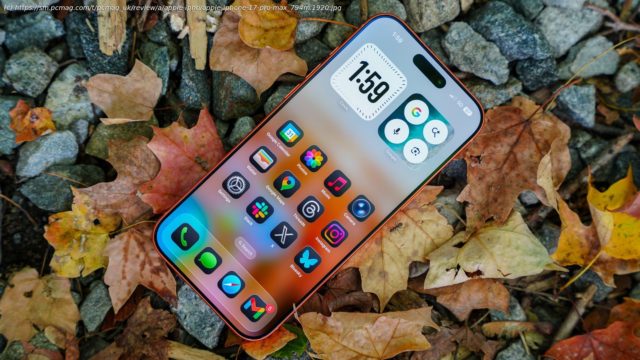Apple’s iPhone 17 Pro Max is a productivity powerhouse that’s worth the high price of entry for content creators who want the phone with the best battery life and the most capable cameras.
The $1,199 Apple iPhone 17 Pro Max is the most powerful phone the company has ever made, and the most feature-rich, highest-performing iPhone you can buy. The refreshed hardware is more durable, the large screen is brighter than ever, and the battery lasts longer than the Pixel 10 and the Galaxy S25 combined. The 17 Pro Max is laudable for these basics alone. Toss in one of the most capable camera and video capture systems on a phone and combine it with exceptional software, and you have a winning formula for creators on the go. Most people should save money and stick to the Editors’ Choice-winning $799 iPhone 17, but the 17 Pro Max is worth its high price if you plan to make use of its broader feature set.Design: Apple Takes It to the Max
Apple is pushing into some fresh territory with the iPhone 17 Pro Max this year. The iPhone Air is a brand-new model, and the iPhone 17 is a rehash of the iPhone 16. But the Pro? Apple carries over the essentials, but the rear panel is a significant departure from the design of previous Pro models. And the color palette is polarizing. Cosmic Orange is a bold choice that feels seasonally appropriate here in the mid-Atlantic states, where the leaves are starting to change with the approach of fall—but the leaves don’t change everywhere. The phone also comes in Deep Blue or Silver. There’s no black, which is likely to upset more than a few people, but the Deep Blue is quite nice.
As expected, the 17 Pro Max is a big phone. It measures 6.43 by 3.07 by 0.34 inches (HWD) and weighs more than half a pound at 8.22 ounces. It’s just a tick larger and weightier than last year’s 16 Pro Max (6.42 by 3.06 by 0.32 inches, 7.99 ounces). It’s certainly the biggest and heaviest of the new iPhones. The iPhone 17 is the smallest (5.89 by 2.81 by 0.31 inches), but the 17 Pro Max is close (5.91 by 2.83 by 0.34 inches), while the iPhone Air is the lightest (5.82 ounces).
Standing next to its Android competitors, the 17 Pro Max measures pretty close to the $1,199 Pixel 10 Pro XL (6.41 by 3.02 by 0.33 inches, 8.18 ounces) and the $1,299.99 Samsung Galaxy S25 Ultra (6.41 by 3.06 by 0.32 inches, 7.69 ounces).
Part of the Pro’s redesign includes an entirely new frame. Apple drops the titanium of last year’s phone and returns to aluminum, which takes the form of a unibody chassis that flows from top to bottom. The raised camera module now stretches across the entire width of the rear panel. It’s so huge that Apple calls it a plateau. Measured at the camera lens, the Pro Max swells to 0.53 inches, a gain of 0.19 inches over the rest of the phone’s thickness. Below the camera plateau, you’ll note a large glass panel insert. The Apple Ceramic Shield protects the bulk of the phone’s rear panel and is complementary in color to the rest of the phone. It’s a somewhat busy look that some may dislike. The good news? You can hide it with a case.
But you probably don’t have to. In addition to the thick aluminum frame and Apple Ceramic Shield rear panel, the front is protected by Apple Ceramic Shield 2, which Apple says is three times more scratch-resistant than the first-generation glass. The phone also has an IP68 rating for protection against dust and water. The Pro Max feels every bit as tough as it looks. It’s the first iPhone since the all-metal iPhone 8 I’d use without a case.
Anyone who’s used an iPhone Pro Max before will know exactly where to find the buttons, controls, and ports. The left edge features the Action Button near the top with two distinct volume keys further down. These big buttons are easy to find and produce satisfying clicks when pressed. The combined screen lock/power button on the phone’s right edge is 0.70 inches long, so you can’t miss it. The Camera Control is slightly more refined than last year’s and can be harder to locate quickly, but its action is just as good.
Apple centers the USB-C (v3.0) port on the bottom edge. I like that the small screws on either side of the port are color-matched to the frame. You’ll also see the speaker grille on the bottom edge and some antenna lines around the outer edges of the frame. A sizable RF window on the top edge allows the phone’s mmWave 5G signals to pass through. It’s a small strip of what appears to be plastic. My review unit has no SIM tray because it’s a US model and is limited to eSIM only. International models still include a SIM tray. Display: The Biggest You Can Get on an iPhone
Apple has aligned the core display specs and features across the iPhone lineup. That means all four phones have excellent screens. The iPhone Pro Max has the biggest of the bunch, and that’s a large part of what makes it a popular choice.
The Pro Max display measures 6.9 inches compared with the Air’s 6.5 inches and the Pro and iPhone 17s’ 6.3 inches. All the screens have the same pixel density of 460 pixels per inch, which means they appear about the same level of sharpness to your eye, even though they have different resolutions. The screen carries over its 1Hz to 120Hz ProMotion technology, which allows it to ramp up the refresh rate for smooth scrolling or slow it down to save power. The brightness now runs from 1,000 nits (typ) to 1,600 nits (HDR) and 3,000 (peak) nits for excellent visibility under even the harshest glare. This is up from a peak of 2,000 nits on the 16 Pro Max. I was always able to see the screen no matter the lighting conditions.
The TrueDepth camera for Face ID remains a core part of the Dynamic Island atop the display. Face ID is a fast and easy way to secure and unlock the phone, and authenticate purchases and apps. The Center Stage selfie camera is there, too. The Dynamic Island is larger than the punch hole cutout common on Android phones, but it mostly disappears even when you’re watching videos. Other things that make the screen great include the oleophobic coating to ward off fingerprints, the 2-million-to-1 contrast ratio, the automatic white balance tool, and the eye fatigue features. Performance: You Don’t Need More Speed Than This
The most expensive iPhone should also be the fastest, right? Not in the case of the iPhone 17 Pro Max.






